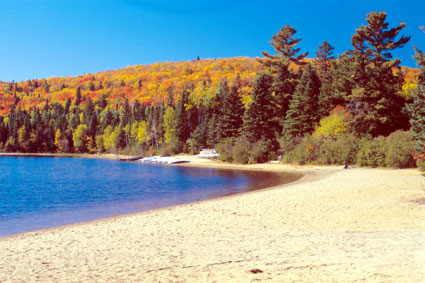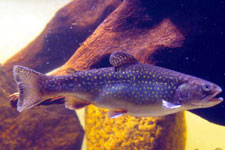page4
Restoring Laurentian aquatic ecosystems
Lakes in La Mauricie National Park of Canada are once again supporting unique Brook trout and Arctic char populations
A vast ecological restoration program is underway to restore the health of aquatic ecosystems in La Mauricie National Park of Canada. The program includes the extensive removal of former dumps and dams and the restoration of aquatic bird nesting sites, as well as forest rehabilitation, anti-poaching surveillance and environmental evaluation. As part of this larger effort, park biologists have begun to implement a plan to restore a sub-species of the Brook trout (Salvelinus fontinalis) in the park's lakes. This sub-species is unique to the park.
La Mauricie National Park, in the heart of Quebec, is a landscape of rounded hills, deep valleys and extensive waterways characteristic of the lower Laurentian Mountains. The park has over 150 lakes, all interconnected by a network of brooks and small, cascading rivers that ultimately flow into the Matawin and Saint-Maurice rivers. These waterways support diverse fish species, including Brook trout, Speckled trout, Lake trout, Northern pike, Small-mouth bass, Yellow perch and Walleye. Français Lake supports the only Arctic char (Salvelinus alpinus) population in the region, which is the southern-most end of its range.
 Beach along the shore of Lake Edouard © Parks Canada / M. Mills / 1997 |
Park staff found that habitat destruction caused by earlier logging activities, poaching and non-native fish introductions by human beings has seriously threatened the existence of many species of indigenous fish. For 120 years, logging and log driving occurred on the majority of what are now park waters. These activities have left a legacy of old dams, logging roads, accumulations of logs on lake bottoms, eroded sediments, and dragged streams. The impact of these activities greatly compromised fish habitat.
In response, Parks Canada has removed a number of dams and stream blockages. At Lac Édouard, park staff replaced the old dam structures with three sills created from rock fill, giving the site a natural flow and appearance. Spawning areas were also created upstream from the dam and between the sills. The drop in the average water level to within natural fluctuation levels for this lake made it possible to enlarge the nearby beach and to recreate many shoreline areas at the northern end of the lake.
The other challenge to the park's aquatic ecosystem is invasive fish species. Today, there are roughly 19 new species of fish that have been voluntarily or involuntarily introduced by people. These species have become a threat to the Brook trout.
Park staff have built a vast inventory of scientific knowledge about the natural wealth of the park's aquatic ecosystems and have directed that knowledge toward efforts to reintroduce and stabilize Brook trout populations. This past year, biologists collected fertilized eggs from this sub-species for over-wintering in an aquaculture facility. This spring, these eggs will be re-introduced into the lakes that their ancestors once inhabited in great numbers.
Results
 Brook (or speckled) trout © Parks Canada / J. Steeves / 1999 |
- Improvements to the ecological integrity of 8% of surface waters (487 hectares) of La Mauricie National Park.
- The 83% increase in the number of lakes with restored fish ecosystems illustrates the significant reduction in the negative impacts caused by logging debris and other human activities.
- The Brook trout has been re-introduced in four lakes. Its genetic integrity has received enhanced protection.
- The removal of six dams and blockages to eight lakes has restored habitat for the Brook trout and Arctic char.
- Date modified :